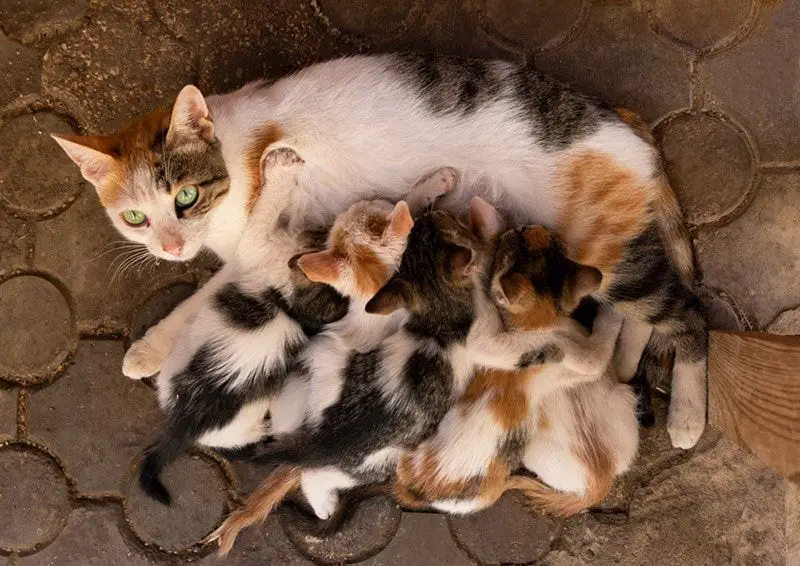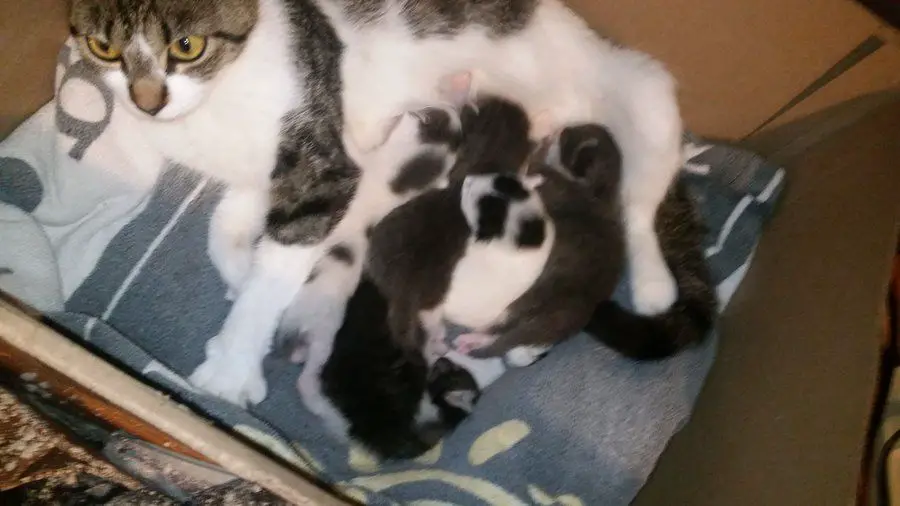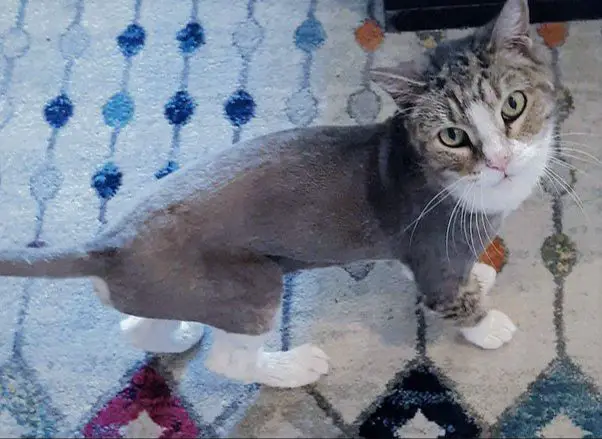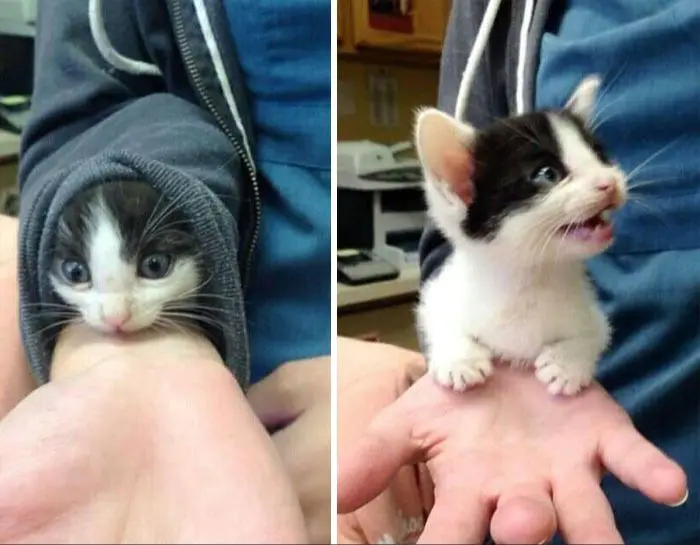What is a Runt Kitten?
A runt kitten is typically the smallest and weakest kitten in a litter of newborn kittens. Runts tend to weigh at least 25% less than their littermates and are visibly smaller in size (source). The typical weight for a newborn kitten is around 100-150 grams, while a runt may only weigh 75 grams or less at birth (source).
There are a few reasons why some kittens are born smaller than others in a litter. Runts often come from large litters where the mother’s nutrition is spread thinner during pregnancy. They may also have experienced growth restriction in the womb due to illness, congenital defects, or poor positioning in the uterus (source). Sometimes there is no underlying cause and the runt kitten is just genetically predisposed to be smaller.
Common Causes of Runt Kittens
There are a few common causes that can lead to a kitten being much smaller than its litter mates:
Genetics – Some breeds, like Siamese, are predisposed to having smaller kittens. If the parents are smaller in size, their kittens may tend to be on the smaller side as well.

Uterine positioning – Where a kitten sits in the uterus can affect its access to nutrients. Kittens on the ends or sides may not receive as much nutrition as those in the middle, stunting their growth.
Illness or malnutrition of the mother – If a mother cat is sick or malnourished during pregnancy, it can prevent nutrients from reaching the fetuses properly. This is a common cause of low birth weights and runts.
In most cases, there is no specific cause for a runt kitten. It is often simply uneven distribution of nutrients in the womb, which can happen by chance in any litter. With care and time, many runts catch up to normal kitten size [1].
Problems Faced by Runt Kittens
Runt kittens often face a number of health and developmental challenges due to their small size. Some common problems faced by runts include:
Difficulty nursing – Runts may have trouble competing with their larger litter mates for nursing time. Their smaller size makes it harder for them to push to the front of the litter. Runts also burn calories faster trying to stay warm, so missing nursing sessions can be especially problematic (1).

Susceptibility to illness – Due to their underdeveloped immune systems and lack of nutrients, runts are more prone to illnesses. Common issues include respiratory infections, diarrhea, fleas, intestinal parasites and poor weight gain (2). Extra care and vet supervision is required.
Socialization issues – The size difference between runts and normal siblings can lead to socialization problems. Runts may become fearful or insecure around larger cats. Early socialization and care is key for runts to develop proper social skills (3).
(1) https://cat-world.com/runt-of-a-cat-litter/
(2) https://www.quora.com/What-are-some-common-health-issues-in-runt-kittens
(3) https://www.justanswer.com/pet-cat/0pnoq-cat-recently-litter-kittens-runt.html
Caring for a Runt Kitten
Taking proper care of a runt kitten requires providing extra attention and monitoring to ensure they thrive. Three key areas to focus on are providing supplemental feeding, keeping the kitten warm, and monitoring weight gain.
Runt kittens may have trouble competing with their larger littermates for nursing, so supplemental bottle feeding is often needed. Using a bottle with kitten milk replacement formula, try to feed the runt every 2-3 hours if possible. Be patient, as they may struggle at first to suckle and swallow. Gently rub the milk on their mouth to stimulate eating. According to vets, feeding runts high-calorie nutritional gel supplements between bottle feedings can also help boost their caloric intake for growth (https://cat-world.com/runt-of-a-cat-litter/).
Due to their small size, runt kittens have difficulty regulating their body temperature. Keep them warm by placing them on a heating pad set to low or an enclosed nesting box with a warmed rice sock. Monitoring the temperature to keep them around 90-95F is optimal, as they can easily get chilled (https://www.quora.com/How-do-I-properly-take-care-of-a-kitten-thats-the-runt-of-the-litter).
Weigh runt kittens daily with a kitchen scale to ensure they are gaining weight appropriately, about 4-8 oz per week. Record weights to monitor progress. If weight gain seems inadequate, contact a vet, as they may need additional medical interventions to thrive.
Long-term Outlook for Runt Kittens
The long-term outlook for a runt kitten can vary depending on the underlying cause of their small size. However, with proper care and nutrition, many runt kittens go on to live normal, healthy lives.
In terms of eventual size, most runts will catch up to the size of their littermates, though some may remain on the smaller side. According to one source, while runts start out very small, they eventually reach close to normal size, usually weighing 8-10 pounds fully grown (https://cat-world.com/runt-of-a-cat-litter/). However, some runts may max out at 6-8 pounds.

When it comes to lifespan, runt kittens generally have similar life expectancies as other cats, which is typically 10-15 years for indoor cats. Their small size at birth does not necessarily impact how long they live. With proper nutrition, veterinary care, and a loving home, runt kittens can live a full life just like other cats (https://justagric.com/how-long-do-runt-cats-live/).
In terms of personality, runts are often described as affectionate, playful, and active. Some sources suggest runts tend to bond strongly with their human caretakers. While challenging early health issues can impact personality, runt kittens have similar temperaments to other cats when raised in a healthy, loving environment.
Identifying Other Small Kittens
Not all small kittens are necessarily runts. There are other reasons a kitten may be smaller than its littermates, such as:
Premature Kittens
Kittens born earlier than the normal 63-65 day gestation period are considered premature. Premature kittens can be underdeveloped and smaller than full-term kittens (see source). They may need extra care like bottle feeding and warming until they are strong enough to nurse and thrive. With dedicated care, premature kittens can go on to develop normally.
Kittens with Developmental Disorders
Genetic conditions, viruses, toxins or poor prenatal nutrition can cause developmental disorders leading to small size. Dwarfism, skeletal abnormalities and neurological problems may be seen. Kittens with severe disorders may not survive, but those with milder forms can live healthy lives if given proper veterinary attention (see source).
Selecting a Runt Kitten
Many people feel drawn to adopting the smallest “runt” of a litter. However, when selecting a kitten, it’s important to consider the cat’s overall health and personality, not just its size.
Runts may require extra care like bottle feeding, veterinary exams, nutritional supplements, and more frequent weigh-ins. So be prepared to provide additional support if adopting the runt. However, healthy runts with no medical issues can still make wonderful pets.
Get to know each kitten’s individual temperament. The runt may seem timid at first but have a sweet personality once settled into a home. Kittens with minor viral or bacterial infections can fully recover. While the runt may be smaller, it can live a long healthy life with proper early nutrition and vet care.[1]

Since runts can face challenges thriving, some people advise waiting to see if the kitten grows bigger before selecting it. But bonding early helps socialization too. Assess the specific runt’s prognosis and then decide if you can provide the extra care required.
With preparation for possible additional needs, adopting a runt can be an extremely rewarding experience, giving an extra-special kitten the opportunity for a great life.
[1] https://www.quora.com/I-m-adopting-a-kitten-who-is-the-runt-of-her-litter-and-she-is-a-little-scared-of-me-Does-anyone-have-any-tips-for-me
Causes of Small Litters
There are a few potential reasons why a cat may only have a single kitten in a litter:
A young, old, or unhealthy mother cat may be more likely to have a small litter size or even just one kitten. Kittens require a lot of energy and nutrition from the mother, so a cat that is not in peak physical health may not be able to support a large litter.1
Pregnancy complications like infections, hormone issues, or nutritional deficiencies can also result in fewer or weaker kittens. Problems during gestation may prevent some embryos from properly developing.2
Some cat breeds are genetically predisposed to having smaller litters, usually ranging from 1-3 kittens. Breeds like Siamese and Ragdolls often have fewer kittens per litter compared to other breeds.1
When to Be Concerned
Small kittens can face additional health challenges that put them at risk for illness or complications. Here are some key signs to monitor that may indicate a need for extra care or veterinary intervention:
- Difficulty breathing, coughing, or nasal discharge – this could signal respiratory issues like pneumonia which can be serious in young kittens (1).
- Frequent diarrhea or vomiting – since kittens have immature immune systems, they are prone to infections that lead to gastrointestinal upset.
- Failure to gain weight at the same rate as litter mates – runts may need supplementary feeding to meet caloric needs for growth.
- Rejected by mother cat – orphaned kittens can decline rapidly without proper care and nutrition.
Kittens that display these problematic symptoms require close monitoring of temperature, blood sugar, hydration levels, and weight. Warm supplemental feedings, antibiotics, and other interventions may be necessary. Calling a veterinarian promptly at the first sign of illness can help get small kittens back on track.
With attentive nursing care and regular veterinary check-ups, many runt kittens mature into healthy, thriving cats. But their vulnerable start means diligent observation and action is needed to identify risks early.
Providing the Best Care
Proper care and attention are especially important for runt kittens to help them thrive. Here are some tips for providing the best possible care:
Nutrition: Runts may need more frequent feedings and a high-calorie formula to help them gain weight. Weigh kittens daily and monitor weight gain. Consult your vet if growth seems slow. Supplement with kitten milk replacer if needed. [1]
Veterinary Care: Schedule regular vet checkups to monitor development. Runts are prone to health issues so veterinary oversight is essential. Discuss supplements or medications that may help. Stay up to date on deworming and vaccines. [2]
Socialization: Give runts extra attention and playtime with littermates. Proper socialization prevents behavior issues. Gently encourage interaction if needed. Supervise play to prevent injuries.
General Tips: Keep environment warm, clean and calm. Handle gently and avoid stress. Monitor litterbox use. Promote activity and muscle development through play. Be patient – progress may be slow but consistency pays off.

